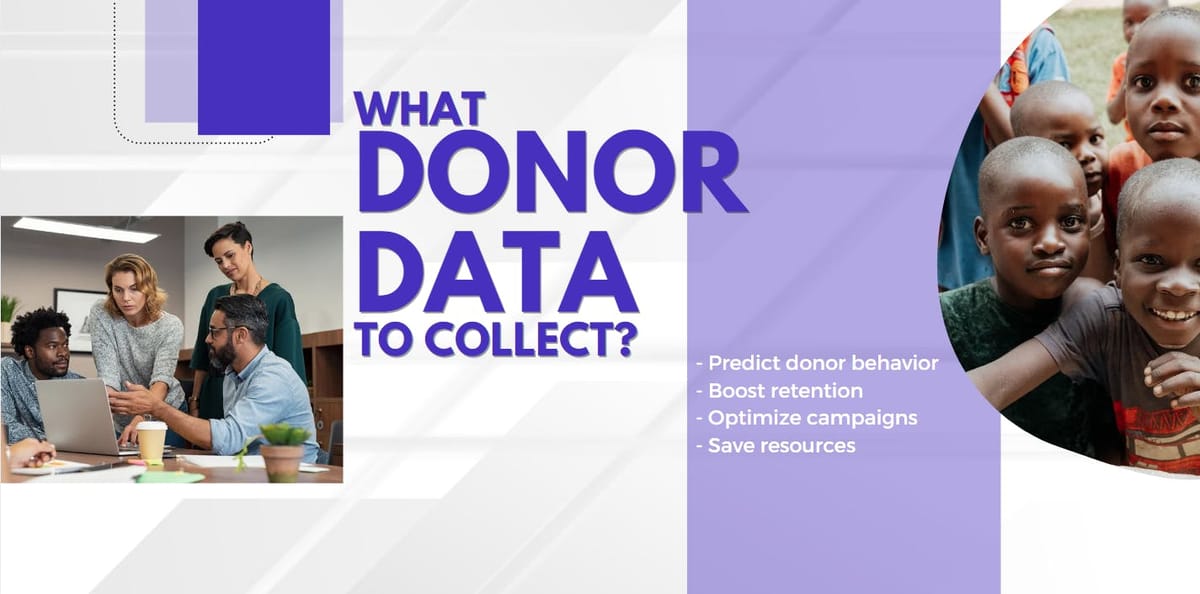Predictive Analytics Fundraising
Explore how predictive analytics can transform nonprofit fundraising, enhance donor relationships, and boost revenue through data-driven strategies.

: Boost Your Nonprofit's Impact
Predictive analytics is revolutionizing fundraising for nonprofits, especially child sponsorship programs. Here's what you need to know:
- What it is: Using data to forecast donor behavior and optimize fundraising strategies
- Key benefits:
- Increased donations (up to 46% more online revenue)
- Better donor retention
- More efficient resource allocation
Related video from YouTube
How to implement predictive analytics:
- Collect the right donor data
- Choose appropriate software (e.g., HelpYouSponsor)
- Set up prediction models
- Track key metrics (retention rate, lifetime value, ROI)
- Avoid common pitfalls (data silos, poor data quality)
Real-world impact: UNICEF Australia saw 26% more net revenue and 35% better campaign ROI using AI-powered predictive analytics.
Data You Need for Predictive Analytics
To use predictive analytics for your child sponsorship program, you need the right data. Here's what to collect and how to keep it safe.
What Donor Data to Collect
Good donor data is key for accurate predictions and personalized fundraising. Here's what you need:
- Basic Info: Name, birthday, email, phone, address. You need these for communication and grouping donors.
- Giving History: How much, how often, and which campaigns. This shows how donors behave and engage.
- Engagement: Event attendance, volunteering, content interactions. Use this to plan your outreach.
- Interests and Motivations: Why donors support you. This helps tailor your messages.
- Business Connections: Useful for finding matching gift opportunities.
"Data collection, understanding, and implementation is vital when creating effective marketing strategies to support your organization's goals." - Jen LaRue, Associate Vice President, Marketing at Big Sea
With this info, you can create personalized donor experiences. An Epsilon study found that 80% of people are more likely to buy when a campaign is personalized.
Keeping Data Safe and Accurate
Good data is just the start. You also need to keep it safe and up-to-date. Here's how:
- Update Regularly: Donor info changes about 30% each year. Set a schedule to keep it current.
- Clean Your Data: Get rid of duplicates, old contact info, and extra data. This helps you communicate better.
- Secure Storage: Use a Level 1 PCI DSS compliant platform to protect donor info from breaches.
- Train Staff: Teach everyone who uses your database how to enter data correctly and consistently.
- Fill in the Gaps: Regularly add missing info like demographics or contact details.
"Taking the time to clean up your donor data will provide a lot of value to your organization." - DonorSnap
These practices will help you keep a clean, accurate, and secure donor database. This will boost your predictive analytics, leading to better fundraising and stronger donor relationships.
Using Prediction Models in Fundraising
Prediction models are shaking up the nonprofit world, especially for child sponsorship programs. These tools help organizations crack the code on donor behavior and see into the future of giving. The result? Fundraising strategies that pack a punch.
Understanding Donor Patterns
By digging into past donations, nonprofits can get a sneak peek at future giving. This knowledge lets them tailor their approach and squeeze the most out of their fundraising efforts.
Take Fundraising KIT's Smart Ask feature. It's like a crystal ball powered by machine learning. It looks at a donor's history and even factors like the weather to suggest the perfect ask amount. The result? Donation rates that go through the roof.
Then there's the Monthly Donor Score. This nifty tool crunches data to pinpoint when each donor is most likely to open their wallet. Armed with this info, nonprofits can:
- Keep donors from getting burned out
- Craft messages that hit home
- Time their outreach for maximum impact
Massachusetts General Hospital has been using BWF's data analytics since 2010. By consistently applying predictive modeling, they've been able to supercharge their fundraising through insight analysis, performance review, and grateful patient scoring.
Spotting Donors Who Might Jump Ship
Catching donors before they bail is crucial for keeping a healthy donor base. Predictive models act like an early warning system, letting nonprofits spot these donors and keep them in the fold.
Here's how nonprofits can use predictive analytics to keep donors from slipping away:
- Dive into giving history: Look for red flags in donation frequency or amount.
- Keep tabs on engagement: Track how donors interact with emails, events, and social media.
- Spot the warning signs: Use data to identify common traits of donors who've ghosted in the past.
Once they've spotted donors on the edge, nonprofits can swoop in with targeted action. They might send a personal note highlighting the impact of past donations or offer new ways to stay involved.
The 2018 Fundraising Effectiveness Survey Report dropped a bombshell: the donor retention rate was only 45.5% in 2017. That means over half of donors didn't come back for seconds, highlighting the need for proactive retention strategies.
To put these insights to work, try this approach:
1. Launch a multi-channel communication blitz
Keep donors in the loop about their impact. Use email, social media, and even good old-fashioned mail to tell your story.
2. Make giving personal
Tailor the experience to each donor's interests and preferences. It's like giving them a VIP pass to your cause.
3. Get donors in on the action
Offer ways for donors to roll up their sleeves and get involved beyond just writing checks. It builds a stronger connection to your mission.
4. Say "thanks" early and often
A heartfelt thank-you goes a long way. It reminds donors that their contribution matters.
Software and Tools You'll Need
To boost your nonprofit's fundraising with predictive analytics, you'll need the right tools. Let's look at some top options and how to set them up.
HelpYouSponsor

HelpYouSponsor is a game-changer for nonprofits running child sponsorship programs. It offers:
- Child sponsorship software
- Fundraising campaign support
- Donor management
What's cool? HelpYouSponsor uses predictive analytics to help you make smarter fundraising decisions.
Pricing:
- Free Plan: For small nonprofits (up to 10 commitments/month)
- Pro Plan: $39/month (up to 80 commitments/month)
- Max Plan: $0.50 per commitment (for bigger organizations)
You only pay for what you use. Nice, right?
Setting Up Your Systems
Don't worry, setting up predictive analytics tools isn't as hard as it sounds. Here's how:
1. Pick your tools
Besides HelpYouSponsor, check out Fundraising KIT or Fundmetric. These AI-powered platforms can dig into your donor database to find giving patterns and predict future behavior.
2. Connect with your database
Your donor database is key. Make sure your new tools can talk to it. For example, Fundraising KIT's Smart Ask feature uses your donor history to suggest the best ask amounts.
3. Train your team
Get your staff up to speed on the new tools. Most providers offer training to help you out.
4. Start small
Try using predictive analytics for one thing first, like donor retention. Fundraising KIT's Monthly Donor Score can help you figure out when each donor is most likely to give.
5. Keep an eye on things
Check how well your new tools are working. Are you raising more money? Saving time? Tweak your approach based on what you see.
Here's what Stephen O'Neill from Fundraising KIT says:
"By incorporating AI-powered tools in everyday processes, fundraisers can better understand the wide range of outside factors that influence decision making, identify more engaged prospects, and build campaigns more strategically."
With the right tools and setup, you'll be on your way to supercharging your fundraising with predictive analytics.
Tracking Results
Let's talk about how to measure the impact of predictive analytics on your fundraising. It's all about knowing which numbers to watch and how to use them.
Numbers to Watch
Here are the key metrics you should focus on:
1. Donor Retention Rate
This is the big one. It shows how many donors stick around from year to year. Here's how you calculate it:
(Number of recurring donors this year / Total donors last year) x 100
For example, if you had 3,400 donors last year and 750 gave again this year, your retention rate is 22%. Don't panic if this seems low - the average for nonprofits is about 45%. Your goal? Bump this number up over time.
2. Donor Lifetime Value (LTV)
LTV helps you see the long-term impact of your donor relationships. Here's the formula:
Average years with organization x Average donation amount x Average contributions per year
Knowing your LTV can help you make smarter decisions about where to focus your efforts.
3. Fundraising Return on Investment (ROI)
This shows how efficient your fundraising campaigns are. Calculate it like this:
[(Total funds raised - Total campaign cost) / Total campaign cost] x 100
Let's say you raised $315,000 and spent $127,000. Your ROI would be 148.03%. That's great - you more than doubled your investment!
4. Donation Growth Rate
This tells you how your donation revenue is changing year-over-year:
[(Total donations this year - Total donations last year) / Total donations last year] x 100
A positive number? You're on the right track. Negative? Time to rethink your strategy.
5. Online Gift Percentage
In our digital world, it's crucial to know how many gifts come in online. This can help you decide where to invest your resources.
"You can't perfect what you can't measure! But, by evaluating your fundraising with several KPIs, you can develop a well-rounded understanding of your fundraising success." - Jack Showers, Nonprofit Research Analyst at KIT.
Here's the key: track these numbers consistently over time. Use them to spot trends, find areas to improve, and celebrate your wins. Many donor management systems can track these for you automatically, saving you time and headaches.
Tips and Common Mistakes
Let's dive into some key tips and pitfalls when using predictive analytics for fundraising.
Data Collection Rules
Good data is the backbone of predictive analytics. Here's how to get it right:
1. Ethical collection is a must
Be upfront about data collection. Don't buy donor lists or use third-party data without permission. Focus on building real relationships instead.
"The donor is giving it willingly - it's not being taken from them by a third party." - Neon One
2. Give donors the reins
Let donors decide how you use their data. Use clear opt-in processes for communications. Don't auto-enroll donors in campaigns.
3. Build profiles naturally
Gather data bit by bit through normal interactions. Use surveys, event sign-ups, and donation processes to collect info over time.
4. Keep data in one place
Use a central CRM system for all donor data. This way, everyone in your org has the same, up-to-date info.
Steering Clear of Problems
Even with good intentions, orgs can hit snags with predictive analytics. Watch out for these:
1. Data silos
Don't keep data in separate, unconnected systems. It can lead to incomplete donor profiles and off-base predictions.
2. Sloppy data
Bad data can throw off your predictive models. Check your data regularly for accuracy and completeness. JCA puts it well:
"You can only report on the data you have - so fundraisers must enter in ALL relevant data to the proper source system that is accessible across the organization."
3. Fixating on revenue
Revenue matters, but it's not everything. Look at other metrics too:
- How many donors stick around
- Cost to get new donors
- How much a donor gives over time
- How engaged donors are (email opens, event attendance, etc.)
4. Forgetting about costs
Keep an eye on what your fundraising efforts cost. High revenue doesn't mean much if your expenses are just as high.
5. Skimping on training
Make sure your team knows how to use your predictive analytics tools. Keep everyone up to speed with regular training.
6. Ignoring insights
Don't let those valuable insights go to waste. Have a plan to review and act on what your analytics tools tell you.
Summary
Predictive analytics is changing the game for nonprofits, especially those running child sponsorship programs. It's not just a buzzword - it's a powerful tool that's helping organizations make smarter decisions and do more good.
Let's look at UNICEF Australia. They teamed up with Dataro, an AI targeting platform, and the results were impressive:
- 26% more net revenue from appeals
- 35% better campaign ROI
- $30,000 saved by sending 15,000 fewer mailers
Taylor Schulz from UNICEF Australia put it this way:
"Dataro has delivered amazing results for UNICEF. This fundraising-specific tool has helped us understand our donors on a much deeper level and empowered us to select the best donors for our appeals. It's given us confidence in who we are targeting and meant that we are raising more, with less cost and less less time spent on making our selections."
So, how does this magic work?
Donor Behavior Modeling
Predictive analytics digs into past data to spot patterns in how donors behave. This helps nonprofits:
- Guess future giving trends
- Spot potential big donors early
- Craft messages that resonate with different donor groups
Take Massachusetts General Hospital. They've been using BWF's data analytics since 2010. By consistently using predictive modeling, they've boosted their fundraising game through smart analysis and patient scoring.
Keeping Donors Around
Here's a tough stat: on average, only about 45% of donors stick around. Predictive analytics can help change that.
These models act like an early warning system. They can flag donors who might be about to stop giving. This lets nonprofits take action:
- Send personalized messages showing the impact of donations
- Offer new ways for donors to get involved
- Run targeted campaigns to win back lapsed donors
AI Joins the Party
AI is taking predictive analytics to the next level for child sponsorship programs. Check out Save World Children's AI Copilot. It's aiming to:
- Improve communication between sponsors and kids
- Give real-time updates on a child's progress
- Let sponsors chat with their sponsored children, no matter where they are
Making Smarter Choices
Predictive analytics helps nonprofits make better decisions across the board. For example:
- Grouping donors: Tailoring outreach based on donor traits
- Improving campaigns: Finding the best channels and messages for different groups
- Using resources wisely: Focusing on high-potential donors and campaigns
To get the most out of predictive analytics, nonprofits should:
- Keep their databases clean and up-to-date
- Set clear rules for handling data
- Update their predictive models regularly
- Train staff to use and understand these tools
Predictive analytics isn't just a fancy tech tool - it's helping nonprofits do more good, more efficiently. And for child sponsorship programs, that means making a bigger difference in kids' lives.
FAQs
How are not for profits using AI?
Nonprofits are jumping on the AI bandwagon to boost their fundraising game and streamline operations. Here's the scoop on how they're putting AI to work:
AI is helping nonprofits slice and dice donor data like never before. It's like having a super-smart assistant that can spot patterns and group supporters based on their giving history and how they engage with the organization. This means nonprofits can tailor their outreach to hit the right notes with different donor groups.
But that's not all. AI is also playing fortune teller, predicting who's likely to give and who might be ready to up their game. This crystal ball effect lets nonprofits focus their energy where it counts.
And let's talk about the boring stuff - AI is taking care of it. All those repetitive tasks that used to eat up staff time? AI's got it covered, freeing up the humans to do what they do best: building relationships and cooking up big-picture strategies.
Here's a real-world example that'll knock your socks off:
The American Cancer Society put AI to the test in a 2022 digital ad campaign. The results? Mind-blowing:
- Donations shot up 117% above their benchmark
- Nearly 70% of donors stayed engaged throughout the campaign
Talk about a home run!
But hold your horses - not everyone's on board yet. A NonProfitHR survey found that 45% of respondents hadn't dipped their toes in the AI pool, with 14% planning to take the plunge within the year.
Ashutosh Nandeshwar from CCS Fundraising is pumped about AI's potential:
"AI can help elevate philanthropic outcomes and, ultimately, better mission fulfillment."
For nonprofits itching to get in on the AI action, the experts say start small:
- Pick a specific fundraising headache you want to solve
- Hunt down AI tools designed to tackle that problem
- Run a test drive to see if it delivers
- If it works, go big
AI's not just a buzzword for nonprofits - it's becoming a game-changer in how they connect with donors and drive their missions forward.

